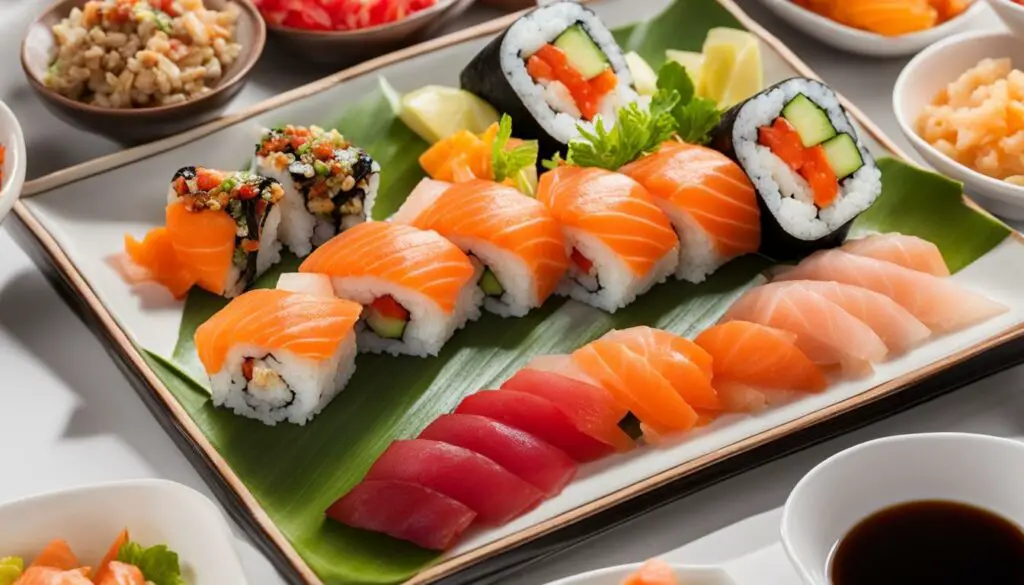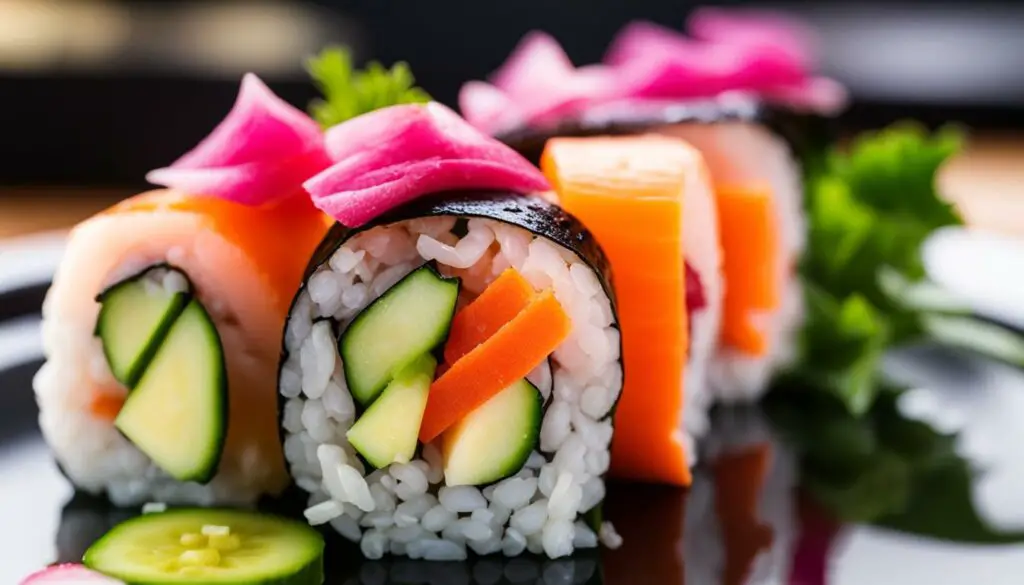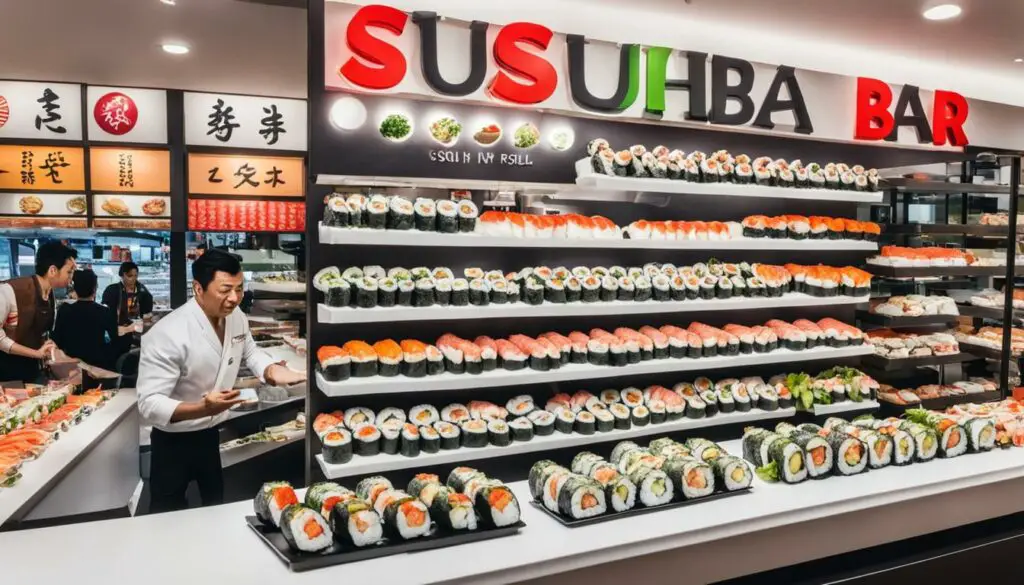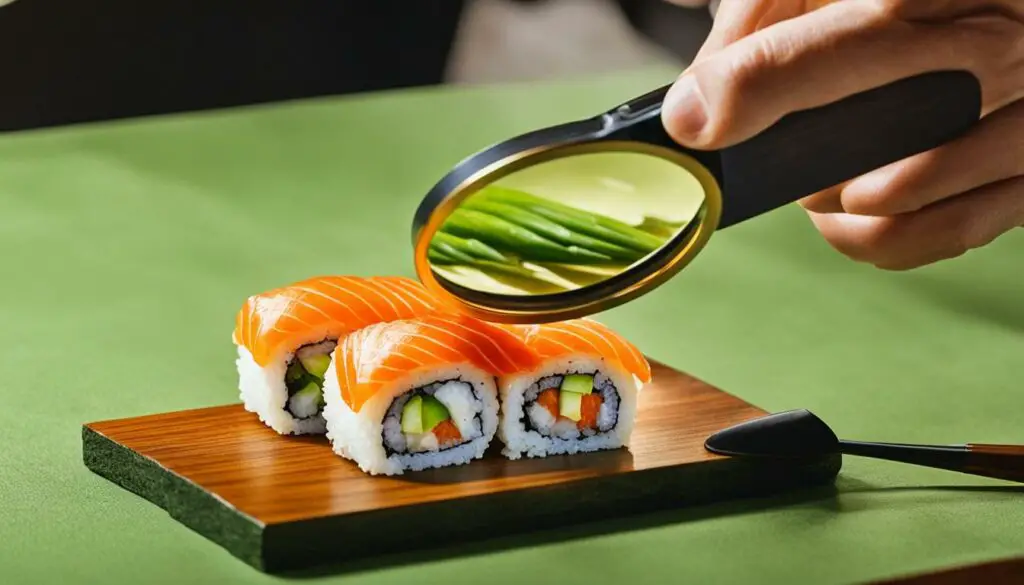Originally posted on December 24, 2023 @ 3:11 am
When it comes to choosing sushi, many people wonder if grocery store sushi is a safe option. With concerns about freshness, quality, and health risks, it’s essential to understand the facts before making a decision. In this article, we’ll dive into the truth about grocery store sushi and provide you with helpful information and tips to make an informed choice.
Table of Contents
Key Takeaways:
- Grocery store sushi is generally safe to eat and is held to the same food safety standards as restaurant sushi.
- The quality of grocery store sushi may be lower compared to high-end sushi restaurants, but it can still be enjoyed if consumed before its expiration date.
- The fish used in grocery store sushi undergoes quality checks, but it may not be as fresh as fish used in high-end sushi restaurants.
- Proper storage and handling, as well as following the expiration date, are essential for ensuring the safety of grocery store sushi.
- If you notice any signs of spoilage, such as mushy rice or an off smell, it’s best to avoid consuming the sushi to prevent potential foodborne illnesses.
The Quality of Grocery Store Sushi

When it comes to the quality of grocery store sushi, there can be significant variation depending on the specific store and supplier. While some grocery stores strive to offer reasonable quality sushi, it’s important to note that the overall quality is generally lower compared to sushi from high-end restaurants. Several factors contribute to this difference in quality:
- The use of lower quality fish: Grocery stores often source their fish from large seafood suppliers, which may not prioritize the same level of quality as high-end sushi restaurants. As a result, the fish used in grocery store sushi may not be as fresh or flavorful.
- Lack of preparation by trained sushi chefs: Unlike high-end restaurants where sushi is carefully crafted by trained sushi chefs, grocery store sushi is typically prepared by staff without specialized sushi-making skills. This can lead to variations in the presentation and technique used in making the sushi.
- Mass production: Grocery stores often produce sushi in large quantities to meet demand, resulting in a more standardized and less individualized approach to sushi preparation. This mass production can impact the overall quality and attention to detail in the sushi.
Despite these factors, it’s worth noting that grocery store sushi can still be enjoyed and is safe to eat if properly stored and consumed before its expiration date. The convenience and accessibility of grocery store sushi make it a popular option for many sushi enthusiasts. However, those seeking a higher quality sushi experience may prefer to opt for sushi from high-end restaurants.
Here’s a visual representation highlighting the key differences between the quality of grocery store sushi and sushi from high-end restaurants:
| Grocery Store Sushi | High-End Restaurant Sushi | |
|---|---|---|
| Fish Quality | Lower quality | Higher quality |
| Sushi Chef | Less trained | Expertly trained |
| Production Process | Mass production | Handcrafted |
| Attention to Detail | Standardized | Individualized |
While grocery store sushi may not match the quality of high-end restaurant sushi, it can still be a convenient and satisfying option for sushi lovers. It’s important to manage expectations and consider personal preferences when deciding between grocery store sushi and sushi from high-end restaurants.
Safety Standards for Grocery Store Sushi

Grocery store sushi is subject to strict food safety standards set by the U.S. Food and Drug Administration (FDA), ensuring the safety of the sushi sold in these establishments. The companies that provide sushi to grocery stores must comply with these regulations to prevent health risks and maintain their licenses. It is important to note that despite sushi containing raw fish, it is not riskier to consume than other prepackaged foods when handled and stored properly.
These safety standards for grocery store sushi encompass various aspects of production, storage, and handling, including:
- Ensuring proper hygiene practices, such as maintaining clean food preparation areas and using gloves during sushi preparation.
- Monitoring and maintaining appropriate temperatures to prevent bacterial growth and ensure freshness.
- Sourcing high-quality ingredients from trusted suppliers.
- Implementing thorough quality checks on fish and other ingredients to detect any signs of spoilage or contamination.
- Properly labeling and dating sushi products to ensure they are consumed within a safe timeframe.
- Training employees on food safety protocols to minimize the risk of cross-contamination and ensure proper handling procedures.
By adhering to these safety standards, grocery stores can provide consumers with sushi that meets the necessary health and safety requirements.
“Ensuring the safety of grocery store sushi is of utmost importance to protect consumers from potential foodborne illnesses. By following these stringent safety standards, grocery store sushi can be enjoyed with confidence.” – Dr. Emily Johnson, Food Safety Expert
To visually understand the safety standards for grocery store sushi, refer to the table below:
| Food Safety Standards for Grocery Store Sushi | Description |
|---|---|
| Hygiene Practices | Maintaining clean food preparation areas, using gloves, and practicing good hand hygiene. |
| Temperature Control | Maintaining appropriate temperatures to prevent bacterial growth and ensure freshness. |
| Ingredient Sourcing | Sourcing high-quality ingredients from trusted suppliers to ensure sushi’s overall safety. |
| Quality Checks | Thoroughly inspecting fish and other ingredients for signs of spoilage or contamination. |
| Labeling and Dating | Properly labeling and dating sushi products to indicate freshness and safe consumption periods. |
| Employee Training | Training employees on food safety protocols to minimize the risk of cross-contamination and ensure proper handling. |
Reasons Why Grocery Store Sushi Might Be Considered Bad

Grocery store sushi often falls short when compared to sushi from high-end restaurants. Here are a few reasons why grocery store sushi might be considered inferior:
- Quality of Fish: Grocery store sushi typically uses fish sourced from large seafood suppliers, which may not undergo stringent quality checks. This can result in lower-quality fish being used, affecting the taste and overall quality of the sushi.
- Lack of Freshness: Unlike sushi served in high-end restaurants where it’s prepared and served immediately, grocery store sushi is often refrigerated to prolong its shelf life. This can compromise the flavor and freshness of the sushi.
- Subpar Ingredients: Grocery store sushi may use lower-grade ingredients, including rice and seaweed, which can affect the overall taste and texture of the sushi.
- Lack of Expertise: Trained sushi chefs are highly skilled in the art of sushi making, paying attention to every detail and employing specific techniques. In grocery store sushi, the attention to detail and expertise may be lacking, resulting in a less refined product.
“The quality of grocery store sushi may be lower due to the use of lower-grade fish, lack of freshness, subpar ingredients, and the absence of expert sushi chefs.”
While grocery store sushi may not match the quality of high-end restaurant sushi, it can still be enjoyed as a convenient and affordable option. However, it’s important to be mindful of these drawbacks and manage expectations when choosing grocery store sushi.
| Drawbacks of Grocery Store Sushi | Quality Issues |
|---|---|
| Lower-quality fish | Lack of freshness |
| Subpar ingredients | Lack of attention to detail from trained sushi chefs |
Signs of Bad Grocery Store Sushi

When it comes to grocery store sushi, it’s important to be aware of the signs that indicate the sushi may have gone bad. Here are a few key indicators to look out for:
- Mushy rice: Fresh sushi rice should be firm and slightly sticky. If the rice in your grocery store sushi feels mushy or pasty, it may be a sign of spoilage.
- Off smell: Sushi should have a clean and mild aroma. If you detect any unpleasant or sour odors coming from the sushi, it’s a clear indication that it’s no longer fresh.
- Mealy texture to the fish: The fish in grocery store sushi should have a firm and silky texture. If the fish feels grainy or mushy, it’s a sign that it has deteriorated and should be avoided.
To ensure the best quality and freshness, it’s recommended to consume grocery store sushi before its expiration date and ideally on the day of purchase. Additionally, it’s crucial to store sushi properly, keeping it refrigerated at the appropriate temperature. By being vigilant and recognizing these signs of bad grocery store sushi, you can help prevent potential foodborne illnesses and ensure a safe dining experience.
Grocery Store Sushi with Raw Fish

While grocery store sushi may not always contain raw fish, there are options available for those who enjoy it. Some grocery stores offer sushi rolls and nigiri sushi that include raw fish like tuna and salmon. It’s important to note that even though the raw fish used in grocery store sushi is safe to eat, it must meet proper storage and handling standards to ensure its safety. Adhering to food safety regulations and maintaining proper temperature control are crucial in guaranteeing the safety of raw fish in grocery store sushi.
By following these guidelines, individuals can enjoy sushi with raw fish from grocery stores without worrying about potential health risks. It’s essential to be aware of the quality and freshness of the sushi, as well as the adherence to safety standards, to ensure a satisfying and safe dining experience.
| Type of Grocery Store Sushi | Description |
|---|---|
| Sushi Rolls | Sushi rolls with raw fish, such as tuna and salmon, wrapped in seaweed and rice. |
| Nigiri Sushi | Hand-formed sushi with a mound of rice and a slice of raw fish, typically served with soy sauce and wasabi. |
These are just a few examples of the types of grocery store sushi that may include raw fish. The availability may vary depending on the store and supplier. It’s important to check the labeling and descriptions to ensure the desired sushi with raw fish is chosen.
In-House Sushi Preparation in Grocery Stores
When it comes to grocery store sushi, some supermarkets go the extra mile by employing trained sushi chefs to prepare the sushi in-house. These skilled chefs bring their expertise and knowledge to the supermarket’s sushi counters, ensuring a higher level of quality and freshness.
Alternatively, some grocery stores partner with companies that specialize in sushi production. These companies provide fresh ingredients and often have their own team of experienced sushi chefs working within the supermarket’s sushi department. This partnership ensures that the sushi available in grocery stores is made with care and attention to detail.
The Benefits of In-House Sushi Chefs
Having in-house sushi chefs in supermarkets has several advantages. Firstly, it allows for greater control over the quality of the sushi. Trained sushi chefs are skilled in selecting the best ingredients and preparing them with precision. They ensure that the fish is fresh and of good quality, and that the sushi is made to perfection.
Secondly, the presence of in-house sushi chefs contributes to the overall freshness of the sushi. They can prepare the sushi shortly before it is made available for sale, ensuring that it is as fresh as possible. This freshness enhances the flavor and texture of the sushi, providing customers with a more enjoyable dining experience.
“Having in-house sushi chefs in grocery stores allows for greater control over the quality and freshness of the sushi.”
Quality Considerations
While in-house sushi preparation in grocery stores elevates the overall quality, it’s important to note that the experience and quality of grocery store sushi may still be lower compared to high-end sushi restaurants. Factors such as the sourcing of ingredients and the scale of production can impact the final product.
Nevertheless, the presence of in-house sushi chefs and the use of fresh ingredients make grocery store sushi a viable option for those who enjoy sushi but may not have access to or prefer not to dine at high-end sushi restaurants.
To summarize, in-house sushi chefs in grocery stores bring expertise and freshness to the sushi counter, contributing to the overall quality of the sushi. Despite certain limitations, grocery store sushi prepared in-house can still provide a satisfying sushi experience for customers looking for convenience without compromising too much on flavor and freshness.
The Popularity of Supermarket Sushi

Supermarket sushi has become increasingly popular in recent years, with a significant increase in sales at grocery stores. In fact, sales of supermarket sushi have risen by approximately 72% over the past four years.
One of the main reasons behind this surge in popularity is the convenience factor. Supermarket sushi offers a quick and easy meal option for busy individuals who are looking for a satisfying and healthy choice on the go. This convenience, coupled with the growing demand for grab-and-go meals, has made supermarket sushi a preferred choice among younger generations.
Moreover, the availability of sushi in supermarkets has not only satisfied the cravings of sushi lovers but also introduced this traditional Japanese delicacy to a wider audience. This accessibility has led to increased sales not only of sushi but also of other ready-to-eat meals offered by supermarkets, as customers are drawn to the variety and convenience provided.
Supermarkets have recognized the popularity of sushi and have invested in sourcing high-grade fresh fish to ensure the quality and taste of their sushi offerings. Many supermarkets also work closely with sushi franchisers to guarantee the availability of sushi for customers who choose this convenient meal option.
Overall, the popularity of supermarket sushi continues to grow, driven by its convenience, expanding consumer base, and the efforts of supermarkets to provide high-quality and delicious sushi options.
The Quality of Supermarket Sushi vs. Restaurant Sushi
When it comes to the quality of sushi, there is a notable difference between supermarket sushi and sushi from high-end restaurants. While supermarket sushi offers convenience and accessibility, it generally falls short in terms of overall quality compared to its restaurant counterpart.
One of the main factors contributing to the difference in quality is the use of lower-grade fish in supermarket sushi. High-end sushi restaurants often source their fish from specialized suppliers who prioritize freshness and quality. In contrast, supermarket sushi may rely on larger seafood suppliers, resulting in fish that may not meet the same level of standards.
Another aspect to consider is the mass production processes involved in creating supermarket sushi. To meet the demand for quick and affordable sushi, supermarkets often use assembly-line techniques, which may compromise the attention to detail and craftsmanship found in sushi prepared by trained chefs at high-end restaurants.
Trained sushi chefs possess a deep understanding of the art and technique behind sushi preparation. Their expertise extends to the selection of ingredients, precise cutting techniques, and the balance of flavors. In contrast, the preparation of supermarket sushi is typically handled by less experienced staff who may lack the same level of expertise and attention to detail.
However, it is important to note that not all supermarket sushi is bad. Some supermarket chains make an effort to offer reasonable quality sushi that can rival certain restaurant options. The overall quality can also vary from store to store, depending on their commitment to sourcing fresh ingredients and maintaining high standards in sushi preparation.
Table: Quality Comparison Between Supermarket Sushi and Restaurant Sushi
| Aspect | Supermarket Sushi | Restaurant Sushi |
|---|---|---|
| Fish Quality | Lower-grade fish | Higher-grade fish |
| Preparation | Mass production processes | Handcrafted by trained chefs |
| Expertise | Less experienced staff | Trained sushi chefs |
| Variety | Limited options | Extensive menu selection |
Ultimately, the choice between supermarket sushi and restaurant sushi comes down to personal preference and expectations. If convenience and affordability are top priorities, supermarket sushi can still be a satisfactory option. However, for those seeking an elevated sushi experience with higher quality ingredients, precise preparation, and refined flavors, high-end sushi restaurants hold the superior edge.
The Safety of Raw Fish in Grocery Store Sushi

Raw fish used in grocery store sushi is generally safe to eat when it meets proper handling, storage, and food safety standards. While there may be concerns about consuming raw fish, especially in a grocery store setting, it’s important to understand that sushi made with raw fish is a staple in Japanese cuisine and has been enjoyed for centuries.
When it comes to the safety of raw fish in grocery store sushi, several factors come into play:
- Proper Handling: Grocery stores that offer sushi generally have protocols in place to ensure the safe handling of raw fish. Sushi chefs and staff are trained in food safety practices to minimize the risk of contamination.
- Storage: Sushi, including sushi with raw fish, is typically stored at controlled temperatures to maintain its quality and safety. It is important that sushi is stored at the proper temperature to prevent the growth of harmful bacteria.
- Sourcing: The source of the raw fish used in grocery store sushi is an important consideration. Reputable suppliers ensure that the fish is properly inspected and handled before it reaches the grocery store.
By following these practices, the risk of foodborne illnesses associated with raw fish consumption is relatively low for healthy individuals. However, it is important to note that vulnerable populations, such as young children, older adults, pregnant women, and individuals with compromised immune systems, may be at higher risk and should exercise caution.
It is also worth mentioning that consuming sushi before its expiration date is crucial. Sushi that has passed its expiration date may not be fresh and may pose a higher risk of foodborne illnesses.
Ultimately, the safety of raw fish in grocery store sushi relies on the adherence to proper handling, storage, and food safety practices. As a consumer, it is essential to be aware of these practices and make informed decisions when purchasing and consuming sushi.
The Differences in Preparation Methods of Supermarket Sushi
Supermarket sushi offers a variety of preparation methods, giving customers a range of options to suit their taste preferences and dietary restrictions. Whether you’re craving nigirizushi, makizushi, temaki, oshizushi, chirashizushi, or inarizushi, you can find it in the sushi section of your local supermarket.
Nigirizushi (Finger-shaped Portions)
One popular type of supermarket sushi is nigirizushi, which consists of small fingers of sushi rice topped with slices of raw or cooked fish, seafood, or other ingredients. Nigirizushi is a traditional form of sushi that showcases the simplicity and natural flavors of the ingredients.
Makizushi (Sushi Rolls)
If you prefer rolls, you’ll find a wide variety of makizushi options at the supermarket. Makizushi is made by rolling sushi rice and various fillings in a sheet of nori (seaweed). Common fillings include cucumber, avocado, cooked or raw fish, and other vegetables. The rolls are then sliced into bite-sized pieces.
Temaki (Hand Rolls)
Temaki, also known as hand rolls, are cone-shaped sushi rolls filled with rice, fish, vegetables, and other ingredients. They are typically larger and more casual than traditional rolls, making them a popular choice for on-the-go sushi lovers.
Oshizushi (Pressed Sushi)
Oshizushi is a style of sushi where the rice and various toppings are pressed into a rectangular mold and then sliced into bite-sized pieces. It often features toppings such as marinated fish, cooked seafood, or vegetables. This method of preparation gives oshizushi a unique appearance and texture.
Chirashizushi (Scattered Sushi)
Chirashizushi is a colorful dish where sushi rice is topped with a variety of ingredients, including raw or cooked fish, vegetables, and pickled items. The toppings are scattered over the rice, creating a visually appealing and delicious sushi bowl.
Inarizushi (Sushi Rice Stuffed in Fried Tofu Pouches)
Inarizushi is a sweet and savory sushi variation in which sushi rice is stuffed into deep-fried tofu pouches called inari. These bite-sized, pocket-like sushi have a slightly sweet taste and are often enjoyed as a snack or side dish.
Supermarket sushi menus may vary depending on the store and supplier, offering you a wide range of choices to satisfy your sushi cravings. Whether you prefer traditional nigirizushi or more creative and contemporary options, you can find a variety of supermarket sushi that caters to your preferences.
Conclusion
Supermarket sushi offers a convenient and accessible option for sushi lovers, and when consumed before its expiration date, it is generally safe to eat. Despite the lower quality compared to high-end restaurant sushi, there are considerations to keep in mind when consuming supermarket sushi.
First and foremost, it is crucial to ensure the freshness of the fish. While the fish used in supermarket sushi undergoes quality checks, it may not be as fresh as fish used in upscale sushi restaurants. Additionally, it is important to pay attention to the handling and storage of the sushi, as refrigeration can affect the flavor and texture of the rice.
Personal preferences also play a significant role. Some individuals may prioritize convenience and affordability over restaurant-quality sushi. Others may have dietary restrictions or limited access to high-end sushi restaurants. By considering these factors and following proper storage guidelines, the risks associated with supermarket sushi can be minimized.
In conclusion, supermarket sushi provides a reasonable and safe option for sushi enthusiasts. While the quality may not match that of high-end restaurants, it can still be enjoyed when the necessary precautions are taken. By being mindful of freshness, handling, storage, and personal preferences, one can make informed decisions when selecting and consuming supermarket sushi.
FAQ
Is grocery store sushi safe to eat?
Grocery store sushi is generally safe to eat and is held to the same food safety standards as restaurant sushi.
What is the quality of grocery store sushi?
The quality of grocery store sushi varies depending on the specific store and supplier. While some grocery stores offer reasonable quality sushi, the overall quality is generally lower compared to sushi from high-end restaurants.
What are the safety standards for grocery store sushi?
Grocery store sushi is subject to the same food safety standards set by the U.S. Food and Drug Administration (FDA) as restaurant sushi. The companies that provide sushi to grocery stores must adhere to these standards to ensure the safety of the sushi they sell.
Why is grocery store sushi considered bad?
Grocery store sushi is often considered inferior to sushi from high-end restaurants due to factors such as the use of lower quality fish, the lack of preparation by trained sushi chefs, and the mass production of sushi.
What are the signs of bad grocery store sushi?
Signs of bad grocery store sushi include mushy rice, an off smell, and a mealy texture to the fish. It is important to consume grocery store sushi before its expiration date and avoid sushi that shows signs of spoilage.
Does grocery store sushi contain raw fish?
While not all grocery store sushi contains raw fish, some sushi rolls and nigiri sushi in grocery stores may include raw fish, such as tuna and salmon.
Are there trained sushi chefs preparing sushi in grocery stores?
Some grocery stores employ trained sushi chefs to prepare sushi in-house, while others may partner with companies that specialize in sushi production.
Why has supermarket sushi become popular?
Supermarket sushi has gained popularity due to its convenience as a grab-and-go meal option and its increasing availability in supermarkets.
How does the quality of supermarket sushi compare to restaurant sushi?
The quality of supermarket sushi is generally considered to be lower compared to sushi from high-end restaurants due to factors such as the use of lower-grade fish, mass production processes, and the lack of expertise from trained sushi chefs.
Is raw fish in grocery store sushi safe to eat?
Raw fish used in grocery store sushi is generally safe to eat when it meets proper handling, storage, and food safety standards.
What are the different types of sushi preparation methods in supermarkets?
Supermarket sushi offers a variety of preparation methods, including nigirizushi, makizushi, temaki, oshizushi, chirashizushi, and inarizushi.
Source Links
- https://thegrocerystoreguy.com/should-i-trust-supermarket-sushi/
- https://ca.finance.yahoo.com/news/why-grocery-store-sushi-always-001555417.html
- https://www.fodmapeveryday.com/what-you-need-to-know-about-supermarket-sushi/
See also:
Leave a Reply